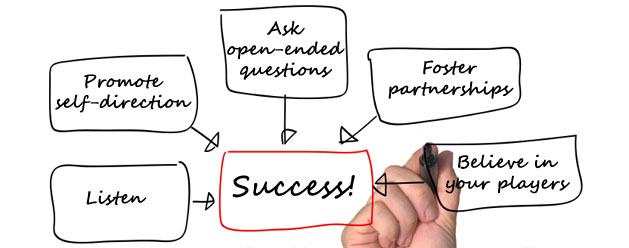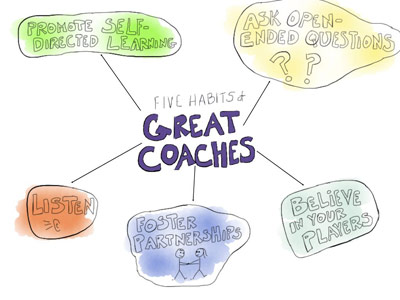Five Habits of Great Classroom Coaches
Foster student performance throughout the project process

In a student-centered, project-based classroom, the teacher roams the classroom, guiding students as they explore, plan, think, and create. We often hear the terms facilitate and “guide on the side” to describe this role, but I think it more useful to think of this role as coaching.
Coaches are more than facilitators; they share a common goal with their players. In sports, the team’s shared goal is to win. Winning occurs in education when students become strong thinkers who can find, analyze, and apply information to solve problems, persuade others, and create something that is useful and/or remarkable.
Coaches always have an outcome in mind and work to help team members reach that goal. Coaches don’t do the playing. They figure out how to get each player to develop and apply the skills and abilities they need to excel.
Coaches do not spend most of their time lecturing or even “front-loading.” Coaches give players opportunities to practice and apply skills in a contextually appropriate situation, providing just-in-time feedback, asking targeted and specific questions, clarifying what is happening, and providing information relevant to what is happening at specific moments.
The project building process minimizes how much of the teacher’s time is spent directing the class from the front of the room. During project building, student learning happens in a functional context… “just in time.” Rather than providing information before the project that may or may not actually be required during the project, content is provided at the moment its need is realized. Students see the relevance of information they are learning because it addresses an immediate need, making it much more likely that they will internalize the content. As the project develops, students evolve into the role of coach for other students, sharing knowledge and information they have already learned.

A classroom coach needs to assist students rather than working and thinking for them. Coaches remove obstacles to learning or help students overcome them. The purpose of this is not to make the process easy, but rather to shift the focus on the learning rather than the obstacles.
The best coaching involves:
- drawing solutions out of the group.
- helping the group achieve results.
- helping the group succeed on their own.
Again, good coaches don’t do the work for the group! The best coaches also believe that their team has tremendous potential.
Effective Coaching Habits
1. Ask Open-Ended Questions
Questions requiring a “correct” answer can be intimidating and do not welcome a variety of responses or discussion. You need to ask questions that solicit ideas, feelings, and opinion, such as “What if...?” or “Why do you suppose…?”
When students aren’t looking for a “correct” answer, there is less stress. They are free to share ideas in a risk-free environment. In this situation, discussion ends only when a solution is found or a new direction is taken.
Closed questions make it easier to evidence short-term success, like better scores on a multiple-choice test, but these isolated bits of content knowledge do not contribute to your your shared goal of developing strong thinkers and learners.
2. Listen
When you listen, you are less likely to direct the group and lead them toward preconceived solutions. When the group asks a question of you, listen to their concerns and reply using an open-ended question that provides just enough information to to keep the discussion moving, allowing students to continue problem-solving on their own.
Learning and growth occur during the process of project-building. Listening helps you ensure that students do not focus solely on the task, product, or end-point. Listen to ensure that students do not miss out on fantastic opportunities for learning.
3. Foster Partnerships
When students look to another member of their group for insight, support, and information, they learn to appreciate the diversity within their group and realize that collaboration can lead to greater results. Refer to actions and suggestions already made by a team member, or ask the group leading questions like, “What ideas have you already come up with?” to ensure they are trying to solve problems on their own before coming to you.
4. Promote Student Self-direction
When students are self-directed, they become responsible for their own learning. As invested learners, they must identify what needs to be learned, identify how they can learn it, and determine how they can best share their knowledge and understanding. Yes, you may need to scaffold as they learn how to manage a project, but it is very easy to over-engineer a project trying to guarantee its success.
Good coaches support personal growth and are available to help students find answers. The best coaches know when to stay back. Floundering isn’t fun, but solving all of your students’ problems for them, and even being the one who always helps a team find the solution, doesn’t build students’ abilities.
5. Believe in Your Players
Push your students to produce the best possible project and solution, and have faith that they can do this without you doing it for them. Be clear on your expectations and trust that they can do the work. If you don’t trust them, you indicate that do not believe in their potential for greatness.
Provide students with opportunities to learn skills and think on their own, but remember to step back. When your students see that you believe in them and that you are willing to let them stand on their own, they want to meet your expectations.
Classroom coaching can help you and your students reached a shared goal of powerful learning. Coaching can help you form strong partnerships with the learners in your classroom, developing trusting relationships that will help your classroom “team” achieve your shared goals.










